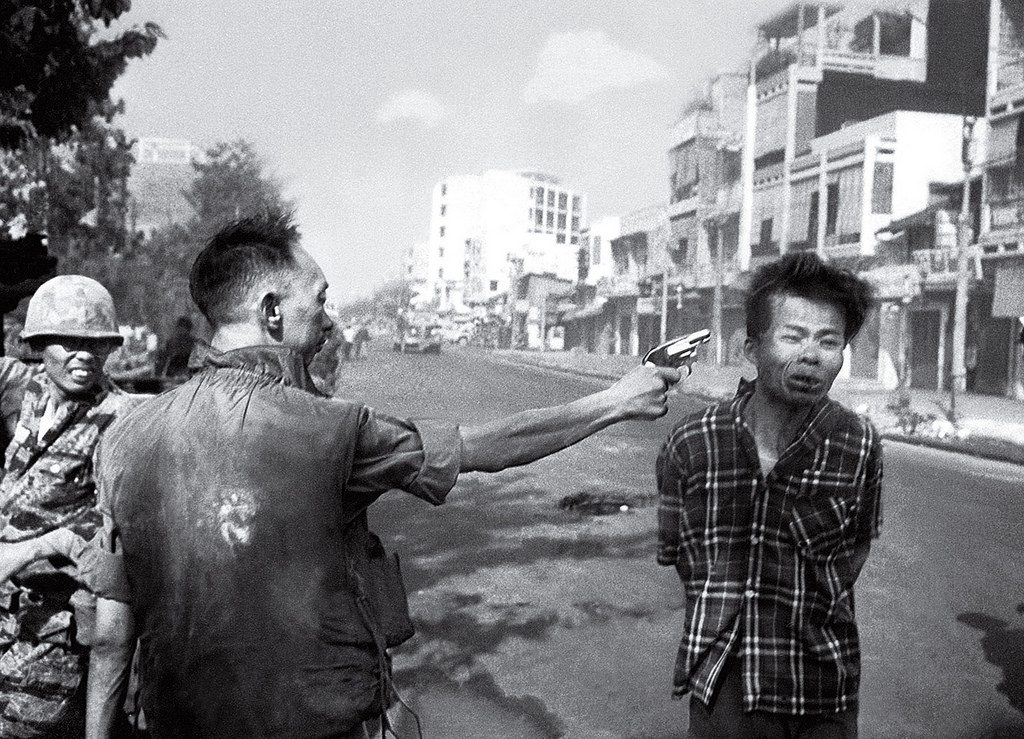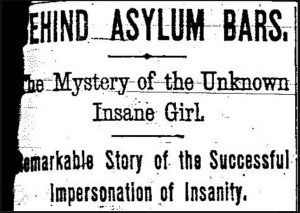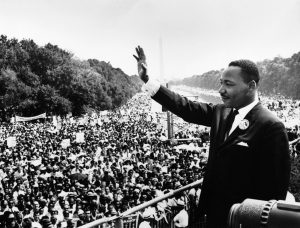Winner of the Fall 2018 StMU History Media Award for
Article with the Best Use of Images
Article with the Best Introduction
The year was 1968. The month of January was almost over and “Tet,” the Vietnamese Lunar New Year, was about to begin. By now, Vietnam had been embroiled for years in a civil war. North Vietnam was under the leadership of a Communist government and South Vietnam was under the leadership of a government that was backed by West. The start of Tet in 1968 was used to launch a huge offensive by the Vietcong in which coordinated attacks took place all over South Vietnam to destabilize the region and push the United States to withdraw.1
The United States‘ intervention in Vietnam began in 1965, a year after the unwarranted attacks by North Vietnam on United States‘ Destroyer ships in the Gulf of Tonkin. By 1967, the number of American troops on the ground surged.2 Despite being involved in this conflict halfway across the globe, the war did not seem so distant with the steady stream of footage and photographs from the front-lines directly to living rooms all over America. In this regard, Vietnam was unique for being one of the first wars to be filmed and photographed extensively.3 The work done by journalists in Vietnam allowed the world to see what was happening in Vietnam firsthand. Among those in Vietnam documenting the war was Eddie Adams.
Eddie Adams had been involved with photography since an early age. He had been a photographer for his high school newspaper and had done some photography work for weddings. Upon graduating high school, he enlisted in the United States Marine Corp. As a Marine, Adams served as a combat photographer in Korea for almost 3 years. In 1965, in what he describes as an “alcoholic haze,” Adams and a close friend decided they would go to Vietnam to document the war.4 During his time in Vietnam is when Adams took the photograph of the Saigon execution.
The day Adams shot the picture featured above was February 1st. He recalls himself and NBC journalists heading toward Cholon, a section of the city of Saigon, because they heard of a battle taking place there. Adams came upon South Vietnamese Brigadier General Nguyen Ngoc Loan executing a Vietcong soldier, in cold blood, in broad day light, in the middle of the street. Adams recalls himself and the other journalist gathering around Loan as he grabbed the soldier. Adams assumed Loan was only going to threaten the man. In the instant Adams raised his camera to snap a photo, Loan raised his pistol and executed the soldier. Loan explained after, that the Vietcong soldier had killed many Americans and allied Vietnamese soldiers.5
The photograph showed up on all major news evening broadcasts and on the front cover of newspapers all over the world the next morning.6 The execution was also recorded, but the specific angle Adams got in his photograph showed the war in an indescribable way. Peter Braestrup, one of the most versed individuals on the Tet offensive, described the picture as a “kind of ultimate horror story that you captured in living color. But in terms of information it told you almost nothing.”7 His quote could not do more justice. What the world saw was a man who was wincing before certain death. They did not know the man was a part of the Vietcong. In the photograph, he seems to be wearing civilian clothes which misleads one. The man had also recently killed allied soldiers and was found armed during martial law- an offense that justifies the use of force.8 Eddie Adams believed he had done an injustice to Loan. He explained, “General Loan was our guy. We were supporting him… believe me, the Americans did just as bad things. I just happened to see this and shoot it…”9

Despite the Johnson Administration’s attempt to win public support of the war, the images of the war painted a very different picture. Public opinion felt that the war was no longer winnable, rather it was now a matter of how America could save face. Walter Cronkite, a well-respected news-anchor and a strong supporter for the war, was among those whose opinion shifted. It was reported that President Johnson believed “if I lost Cronkite, I’ve lost America.”10 The irony of it all was that the Tet Offensive was largely a failure for the Vietcong in terms of land gained and damage inflicted, but in the end its psychological impact on how Americans believed the war to be going, led to its success.11

While this photo was taken out of context, it did provide small truths of the war. Although the war was going well, horrendous acts were being committed. Eddie Adams and many others were able to expose the world to the atrocious acts being committed during the war. Nick Ut’s photo of a napalm strike on a village, is another photo that came to define the war. Ut’s photograph captured the moment children run away in horror from napalm strikes on their village.12 The shattered innocence and utter despair on the childrens’ faces while soldiers seem calm provides a stark incomprehensible contrast that pulls at the heart. These photographs captured only instances of the war. But in the frozen state of a photograph, one is able to examine and reexamine a photograph and truly take in all its details. There was no propaganda campaign that could ever keep a just people supporting a war when they saw photographs like these.

As journalist, Adams and the others were simply doing their jobs. Horst Faas explained about documenting the war, “I don’t think we influenced the war… [he believed simply that the job of journalist was to] record the suffering, the emotions and the sacrifices of both the Americans and the Vietnamese…”13 Their work allowed for the false reality America was living to fall apart. As Americans lived, worked, and played, the very basic rights all humans are entitled to were violated by both sides. As such, Americans responded. In 1973, with public support overwhelmingly against the war in Vietnam, the United States signed the Paris Agreement that led to the withdrawal of all American troops.14 The involvement of the United States in Vietnam continues to be synonymous with some of the most appalling violations of human rights, not only violations against Vietnamese civilians burned alive with napalm or killed slowly through cancer with massive exposure to Agent Orange, but also of the atrocities committed or witnessed by US forces. In addition, all US Soldiers exposed to Agent Orange in indirect ways as when combat medics who worked at Clark Air Force Base (Philippines Islands) received the US soldiers injured in Vietnam who had been evacuated by air. These combat medics received soldiers injured in the field in Vietnam covered in Agent Orange with no protocol for decontamination for the injured nor for themselves as medical personnel. Fifty years on and they continue to die from cancers caused by exposure to Agent Orange. While the US left in 1973, the human suffering due to human rights violations done then, continues today. These images changed the public opinion and changed the course of history even when they may have not saved all those involved at the time, they avoided even greater damages and loss of life, for that we are grateful to these powerful images.
- Patrick Hagopian, America in the World, 1776 to the Present: A Supplement to the Dictionary of American History (Farmington Hills, MI: Charles Scribner’s Sons, 2016), 752. ↵
- James H. Willbanks, Vietnam War: A Topical Exploration and Primary Source Collection (Santa Barbara, CA: ABC-CLIO, 2017), 133, 183. ↵
- James H. Willbanks, The Tet Offensive: A Concise History (New York: Columbia University Press, 2007), 5-6. ↵
- Encyclopedia of World Biography, 2nd Edition, s.v. “Eddie Adams” (Detroit: Gale, 2005), 4. ↵
- Encyclopedia of World Biography, 2nd Edition, s.v. “Eddie Adams” (Detroit: Gale, 2005), 4. ↵
- David Culbert, Television’s Visual Impact on Decision-Making in the USA, 1968: The Tet Offensive and Chicago’s Democratic National Convention, Journal of Contemporary History Vol. 33 (1998): 421. ↵
- David Culbert, Television’s Visual Impact on Decision-Making in the USA, 1968: The Tet Offensive and Chicago’s Democratic National Convention, Journal of Contemporary History Vol. 33 (1998): 424. ↵
- David Culbert, Television’s Visual Impact on Decision-Making in the USA, 1968: The Tet Offensive and Chicago’s Democratic National Convention, Journal of Contemporary History Vol. 33 (1998): 423, 426-428 ↵
- Encyclopedia of World Biography, 2nd Edition, s.v. “Eddie Adams” (Detroit: Gale, 2005), 4-5. ↵
- James H. Willbanks, Vietnam War: A Topical Exploration and Primary Source Collection (Santa Barbara, CA: ABC-CLIO, 2017), 255. ↵
- James H. Willbanks, Vietnam War: A Topical Exploration and Primary Source Collection (Santa Barbara, CA: ABC-CLIO, 2017), 249 ↵
- Hal Buell, The Napalm Girl, Vietnam 25, no. 1 (June 2012), 36-39. ↵
- Deborah Stadler, Frontline Focus, Military History 33, no. 6 (March 2017), 56-61. ↵
- “12 Address to the Nation Announcing Conclusion of an Agreement on Ending the War and Restoring Peace in Vietnam. January 23, 1973.” 2001. American Reference Library – Primary Source Documents, (January, 1.) ↵



188 comments
Avery Looney
This article was very interesting and was a great read. I am very familiar with the Vietnam war but I have never seen this picture before. The photograph taken by Eddie Adams showed just how ruthless the war was. After his photo became viral it was hard for Americans to support the war. The photos of the execution of a Viet Song lieutenant and the other photo of the children running went viral and changed the perspective of how Americans viewed the war.
Sienna Guerra
Vietnam was one of those wars I never really knew about until high school learning more in depth about it. This article also was very beneficial to the knowledge I have now as well. First of all, great article and congrats on being nominated for best use of pictures! Second, this picture is powerful yet disheartening that took a toll and huge effect on humanity overall. Great article!
Daniela Cardona
This article speaks volumes to me about our society as well as about art. A picture really can say 1000 words. It evokes emotions of all kinds and even acts as a call to action, like in this case. This picture highlights the skill of the photographer as well as the importance of art in our world today. As far as society goes, it proves we tend to ignore things until it is too late. Another poor man had to die to cause a reaction of wanting to end the war. It wasn’t enough to hear about all that was going on for the people in our world because it wasn’t effecting our society personally. It took seeing it, seeing someone at the moment of their death to finally spark a light that wanted justice.
Matthew Wyatt
It’s important to understand the impact of good journalism and the good that can be accomplished from reporting in the most dangerous places in the world. This article highlights that power and how it managed to end a truly unfortunate chapter in world history. The article would, however, benefit from another round of critical editing. There are a number of run-on sentences and small typos that can be easily fixed. For example, in the first sentence of the last paragraph, the word “journalist” should be pluralized. These edits will help strengthen the important point the article is trying to make.
Rebecca Campos
This article was very well written and was very interesting to read. In this case, the phrase “a picture is worth a thousand words” was definitely applicable. Now what the words say are another story. It’s fascinating to me how much perspective matters when looking at a photo and in this case, how easily it can be taken out context. Eddie’s viral photo opened the world’s eyes to reality of war regardless of how the photo was perceived. Even though the photo might not have had the initial effect intended, Eddie’s powerful photo still contributed to changing the way the war was perceived and helped so many people with his one simple action.
Robert Rees
This article is a prime example of the power of photography. A technology that has existed since the American Civil War, and has documented many wars since then, is powerful enough to end a conflict with just one still shot. The picture was not even intended to incite anti-war emotions, yet it helped spur the anti-war movement state side to continue fighting for the end of a costly and ultimately unnecessary and tragic war.
Irene Astran
The hardest situations for me to handle are those in which I can see pain and fear in children’s lives. They are so innocent and had nothing to do with the political climate of our day, but nevertheless they become victims of wars such as this. The pictures you incorporated in this piece were very effective to pull this emotional response.
Ximena Mondragon
I know much about the Vietnam because of my brother but I’ve never seen this picture. The Vietnam war like all the other wars are very sad because it takes a toll on humanity and the people affected by it. This was the first time a war was covered in newspapers and television. This picture is so powerful and sad . I think the picture that impacted me the most was the one of the children running. Overall, this article is very well written and the images are impactful.
Madison Downing
I never knew that the picture with the Vietnamese solider was shooting a Vietcong member was showing the support for the south and not something that was suppose to be seen as evil. But who would have thought because of this picture it turned the outcome of the war and the American involvement with this country and its issues. It was because of the photos taken by brave men who stopped to flash a camera that Americans saw that their presence was only matters worse for innocent people who were dying of another’s cause.
Ariana Melendez
Prior to reading this article, I did not know much about the process of the Vietnam War being exposed to the American society of the time. It is heartbreaking to see how the pictures reflect the haunting war. It’s also crazy to think that these images were witnessed by adults and children alike. This article does a great job at depicting the pain the war brought to Americans across the country. It helps me understand the reasoning behind the lack of support the war received.